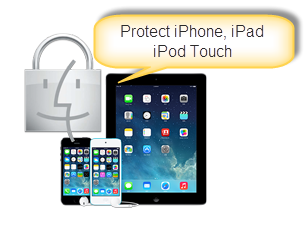Which iOS devices do you have, iPad, iPhone or iPod? Do you worry about that the files on your iOS device are not safe enough? Well, here I list 5 methods of iOS data protection, you can protect iPhone, iPad or iPod and keep the files in a safe state.
1. iTunes Backup
When you connect your iOS device to your Mac or PC, it will be back up the entire system via iTunes. Backup usually only takes a few seconds, and automatically. If you have a chance to recover files on Mac or Windows for iOS device from backup, you will find it exactly recovered the same before backup, from contacts to call records, from the data to the settings of a single application, or even the position of a single application on the Home screen.
How to use?
As long as you connect your iOS device to your computer with iTunes installed already, your data is automatically backed up (to ensure that automatic synchronization is not disabled). Open the device tab from iTunes, you can manually delete old backups. A new device or in backup status device will be automatically ask you to restore operation when the first activated.
2. State Preservation
Similar to the automatic save and restore functionality on Mac OS X system, iOS provides API interfaces to third-party developers for their applications to join the state preservation. So that the application can always ensure your data is stored, even the application crash suddenly. This feature allows the user to start and launch applications on iOS just like to do simple switching operation.
How to use?
This is one system-level function for developers. The user does not need to do anything.
3. Security Mechanism Against Malicious Programs
People often say that Mac OS X system more secure because of its market share in the desktop operating system is not high. However, it also have rarely malicious programs despite it is more and more popular, while iOS system is completely no malicious programs, so that the market share is not the only reason.
How to use?
Most of Security Mechanisms in Apple's operating system are automatic and do not require user intervention. Mac OS X system built-in firewall default as off, but for security reasons, it is best to open it manually: System Preferences - Security and Privacy - Firewall.
4. Encryption Anywhere
Apple's encryption technology is built-in every part of their system. From desktop systems to mobile operating system backup, to a Web-based synchronization, all things can be encrypted. One of the biggest advantages is that the data will no longer vulnerable to malicious attacks; and when the data is lost, users can remotely cleared the data within seconds
How to use?
In Mac OS X, Apple's encryption technology is called FileVault, via System Preferences - Security and Privacy - FileVault to open. In order to prevent forgetting your password, remember to save the recovery key in a safe place. For iOS devices, the default already have system-level encryption, but the backed up can also be encrypted from the iTunes Summary tab.
5. iCloud
Users can able to synchronize their bookmarks, calendar, contacts and e-mail (also including applications, documents, music, photos, and other files) through network to iCloud. This would mean that the most of the sensitive data will be stored in the cloud, so that the possibility of theft or loss of data will be greatly reduced.
Комментариев пока нет.
Будь первым - напиши свой комментарий.